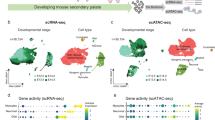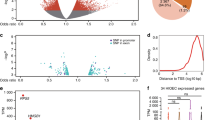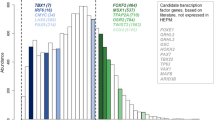Abstract
Isolated cleft lip with or without cleft palate and cleft palate are among the most common human birth defects. Several candidate gene studies on MSX1 have shown significant association between markers in MSX1 and risk of oral clefts, and re-sequencing studies have identified multiple mutations in MSX1 in a small minority of cases, which may account for 1–2% of all isolated oral clefts cases. We explored the 2-Mb region around MSX1, using a marker map of 393 single nucleotide polymorphisms (SNPs) in 297 cleft lip, with or without cleft palate, case–parent trios and 84 cleft palate trios from Maryland, Taiwan, Singapore, and Korea. Both individual markers and haplotypes of two to five SNPs showed several regions yielding statistical evidence for linkage and disequilibrium. Two genes (STK32B and EVC) yielded consistent evidence from cleft lip, with or without cleft palate, trios in all four populations. These two genes plus EVC2 also yielded suggestive evidence for linkage and disequilibrium among cleft palate trios. This analysis suggests that several genes, not just MSX1, in this region may influence risk of oral clefts.
Similar content being viewed by others
Log in or create a free account to read this content
Gain free access to this article, as well as selected content from this journal and more on nature.com
or
References
Marazita ML, Lidral AC, Murray JC : Genome scan fine-mapping candidate gene analysis of non-syndromic cleft lip with or without cleft palate reveals phenotype-specific differences in linkage association results. Hum Hered 2009; 68: 151–170.
Mossey PA, Little J : Epidemiology of oral clefts: an international perspective; in Wysnynski DF (ed): New York: Cleft Lip and Palate 2002, pp 127–158.
Saal HM : Classification and description of nonsyndromic clefts; in Wysnynski DF (ed): New York: Cleft Lip and Palate 2002, pp 47–52.
Jugessur A, Murray JC : Orofacial clefting: recent insights into a complex trait. Curr Opin Genet Dev 2005; 15: 270–278.
Hayes C : Environmental risk factors and oral clefts; in Wysnynski DF (ed): New York: Cleft Lip and Palate 2002, pp 159–168.
Marazita ML, Neiswanger K : Association studies; in Wysnynski DF (ed): New York: Cleft Lip and Palate 2002, pp 240–253.
Vieira AR : Unraveling human cleft lip and palate research. J Dent Res 2008; 87: 119–125.
Shi M, Mostowska A, Jugessur A et al: Identification of microdeletions in candidate genes for cleft lip and/or palate. Birth Defects Res A Clin Mol Teratol 2009; 85: 42–51.
Entrez Gene, http://www|.ncbi.nlm.nih.gov/entrez/.
Blin-Wakkach C, Lezot F, Ghoul-Mazgar S et al: Endogenous Msx1 antisense transcript: in vivo and in vitro evidences, structure, and potential involvement in skeleton development in mammals. Proc Natl Acad Sci USA 2001; 98: 7334–7336.
Sherry ST, Ward MH, Kholodov M et al: dbSNP: the NCBI database of genetic variation. Nucleic Acids Res 2001; 29: 308–311.
van den Boogaard MJ, Dorland M, Beemer FA et al: MSX1 mutation is associated with orofacial clefting and tooth agenesis in humans. Nat Genet 2000; 24: 342–343.
Marazita ML, Field LL, Cooper ME et al: Nonsyndromic cleft lip with or without cleft palate in China: assessment of candidate regions. Cleft Palate Craniofac J 2002; 39: 149–156.
Park J, Park BY, Kim HS et al: MSX1 polymorphism associated with risk of oral cleft in Korea: evidence from case–parent trio and case–control studies. Yonsei Med J 2007; 48: 101–108.
Tongkobpetch S, Siriwan P, Shotelersuk V et al: MSX1 mutations contribute to nonsyndromic cleft lip in a Thai population. J Hum Genet 2006; 51: 671–676.
Otero L, Gutiérrez S, Cháves M, Vargas C, Bérmudez L : Association of MSX1 with nonsyndromic cleft lip and palate in a Colombian population. Cleft Palate Craniofac J 2007; 44: 653–656.
Fallin MD, Hetmanski JB, Park J et al: Family-based analysis of MSX1 haplotypes for association with oral clefts. Genet Epidemiol 2003; 25: 168–175.
Jezewski PA, Vieira AR, Nishimura C et al: Complete sequencing shows a role for MSX1 in non-syndromic cleft lip and palate. J Med Genet 2003; 40: 399–407.
Shih JY, Yang SC, Hong TM et al: Collapsin response mediator protein∣-1 and the invasion and metastasis of cancer cells. J Natl Cancer Inst 2001; 93: 1392–1400.
Bellus GA, Hefferon TW, Luna RIO et al: Achondroplasia is defined by recurrent G380R mutations of FGFR3. Am J Hum Genet 1995; 56: 368–373.
Oliphant A, Barker DL, Stuenlpnagel JR et al: BeadArray technology: enabling an accurate, cost-efficient approach to high-throughput genotyping. Biotechniques 2002; 32: S56–S61.
Fan JB, Oliphant A, Shen R et al: Highly parallel SNP genotyping. Cold Spring Harb Symp Quant Biol 2003; 68: 69–78.
Laird NM, Horvath S, Xu X : Implementing a unified approach to family-based tests of association. Genet Epidem 2000; 19 (Suppl 1): S36–S42.
Rabinowitz D, Laird N : A unified approach to adjusting association tests for population admixture with arbitrary pedigree structure arbitary missing marker information. Hum Hered 2000; 50: 211–223.
Stata Corporation: Intercooled Stata for Mac, version 8.2,. College Station: TX, 2005.
Weinberg CR : Methods for detection of parent-of-origin effects in genetic studies of case–parents triads. Am J Hum Genet 1999; 65: 229–235.
Knapp M, Becker T : Family-based association analysis with tightly linked markers. Hum Hered 2003; 56: 2–9.
Becker T, Knapp M : Maximum-likelihood estimation of haplotype frequencies in nuclear families. Genet Epidemiol 2004; 27: 21–32.
Becker T, Baur MP, Knapp M : Detection of parent-of-origin effects in nuclear families using haplotype analysis. Hum Hered 2006; 62: 64–76.
Barrett JC, Fry B, Maller J et al: Haploview: analysis and visualization of LD and haplotype maps. Bioinformatics 2005; 21: 263–265.
Mathias RA, Gao P, Goldstein JL et al: A graphical assessment of P-values from sliding window haplotype tests of association to identify asthma susceptibility loci on chromosome 11q. BMC Genet 2006; 7: 38.
McKusick VA, Egeland JA, Eldridge R, Krusen DE : Dwarfism in the Amish The Ellis-van Creveld syndrome. Bull Johns Hopkins Hosp 1964; 115: 306–336.
Digilio MC, Marino B, Giannotti A, Dallapiccola B : Single atrium, atrioventricular canal/postaxial hexodactyly indicating Ellis-van Creveld syndrome. Hum Genet 1995; 96: 251–253.
Spranger S, Tariverdian G : Symptomatic heterozygosity in the Ellis-van-Creveld syndrome? Clin Genet 1995; 47: 217–220.
Online Mendelian Inheritance in Man, Weyers Acrofacial Dysostosis [193530], http://www.ncbi.nlm.nih.gov/entrez/dispomim.cgi?id=193530 accessed October 31 2006.
Hecht JT, Mulliken JB, Blanton SH : Evidence for a cleft palate only locus on chromosome 4 near MSX1. Am J Med Genet 2002; 110: 406–407.
Hatsuzawa K, Hirose H, Tani K et al: Syntaxin 18, a SNAP receptor that functions in the endoplasmic reticulum, intermediate compartment, and cis-Golgi vesicle trafficking. J Biol Chem 2000; 275: 13713–13720.
Nkajima K, Hirose H, Taniguchi M et al: Involvement of BNIP1 in apoptosis and endoplasmic reticulum membrane fusion. EMBO J 2004; 23: 3216–3226.
Bassett T, Harpur B, Poon HY et al: Effective stimulation of growth in MCF-7 human breast cancer cells by inhibition of syntaxin18 by external guide sequence and ribonuclease P. Cancer Lett 2008; 272: 167–175.
Sperber G : Formation of the primary palate; in: Wysnynski DF (ed): New York: Cleft Lip and Palate 2002, pp 6–7.
Sperber G : Palatogenesis: closure of the secondary palate; In: Wysnynski DF (ed): New York: Cleft Lip and Palate 2002, pp 14–23.
Menezes R, Marazita ML, Goldstein McHenry T et al: AXIS inhibition protein 2, orofacial clefts and a family history of cancer. J Am Dent Assoc 2009; 140: 80–84.
Online Mendelian Inheritance in Man, Orofacial Cleft 1 [119530], http://www.ncbi.nlm.nih.gov/entrez/dispomim.cgi?id=119530 accessed June 21 2009.
Karolchik D, Baertsch R, Diekhans M et al: The UCSC genome browser database. Nucl Acids Res 2003; 31: 51–54.
Acknowledgements
We thank all participants and staff members at each institution who contributed data for this project. We also thank the Johns Hopkins SNP Center for carrying out the genotyping. This study was supported by NIH R01-DE-01448 (THB) and NIH R01-DE-013939 (AFS).
Author information
Authors and Affiliations
Corresponding author
Additional information
Supplementary Information accompanies the paper on European Journal of Human Genetics website
Rights and permissions
About this article
Cite this article
Ingersoll, R., Hetmanski, J., Park, JW. et al. Association between genes on chromosome 4p16 and non-syndromic oral clefts in four populations. Eur J Hum Genet 18, 726–732 (2010). https://doi.org/10.1038/ejhg.2009.228
Received:
Revised:
Accepted:
Published:
Issue date:
DOI: https://doi.org/10.1038/ejhg.2009.228
Keywords
This article is cited by
-
YANK2 activated by Fyn promotes glioma tumorigenesis via the mTOR-independent p70S6K activation pathway
Scientific Reports (2024)
-
Msx1 loss suppresses formation of the ectopic crypts developed in the Apc-deficient small intestinal epithelium
Scientific Reports (2019)
-
Deleterious coding variants in multi-case families with non-syndromic cleft lip and/or palate phenotypes
Scientific Reports (2016)
-
Clinical relevance of breast cancer-related genes as potential biomarkers for oral squamous cell carcinoma
BMC Cancer (2014)
-
Calcium-binding protein S100P and cancer: mechanisms and clinical relevance
Journal of Cancer Research and Clinical Oncology (2012)



